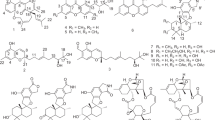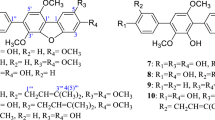Abstract
Five new pyrazin-2(1H)-one derivatives, ochramides A–D (1–4) and ochralate A (5), as well as three known analogues (6–8) were isolated from the fermentation broth of the marine coral-derived halotolerant Aspergillus ochraceus LCJ11-102 in a nutrient-limited medium containing 10% NaI. Their chemical structures were determined by analyzing NMR and X-ray diffraction data. Compounds 2, 5 and 6 showed antimicrobial activities against Enterobacter aerogenes with the MIC values of 40.0, 18.9, and 20.1 μM, respectively.





Similar content being viewed by others
References
Abrell LM, Borgeson B, Crews P (1996) Chloro polyketides from the cultured fungus (Aspergillus) separated from a marine sponge. Tetrahedron Lett 37:2331–2334
Adam W, Bhushan V, Fuchs R, Kirchgassners U (1987) Functionalized 1,2-dioxetanes as potential phototherapeutic agents: the synthesis of carboxylate, carbonate, carbamate, and ether derivatives of 3-(hydroxymethyl)-3,4,4-trimethyl-1,2-dioxetane. J Org Chem 52:3059–3062
Alvarez ME, White CB, Gregory J, Kydd GC, Harris A, Sun HH, Gillum AM, Cooper R (1995) Phevalin, a new calpain inhibitor, from a Streptomyces sp. J Antibiot 48:1165–1167
Bian XQ, Shao ML, Pan HQ, Wang KB, Huang SD, Wu X, Xue CM, Hua HM, Pei YH, Bai J (2016) Paenibacillin A, a new 2(1H)-pyrazinone ring-containing natural product from the endophytic bacterium Paenibacillus sp. Xy-2. Nat Prod Res 30:125–130
Cui CM, Li XM, Li CS, Sun HF, Gao SS, Wang BG (2009) Benzodiazepine alkaloids from marine-derived endophytic fungus Aspergillus ochraceus. Helv Chim Acta 92:1366–1370
Cui CM, Li XM, Meng L, Li CS, Huang CG, Wang BG (2010) 7-Nor-ergosterolide, a pentalactone-containing norsteroid and related steroids from the marine-derived endophytic Aspergillus ochraceus EN-31. J Nat Prod 73:1780–1784
Fang W, Lin XP, Zhou XF, Wan JT, Lu X, Yang B, Ai W, Lin J, Zhang TY, Tu ZC, Liu YH (2014) Cytotoxic and antiviral nitrobenzoylsesquiterpenoids from the marine-derived fungus Aspergillus ochraceus Jcma1F17. Med Chem Commun 5:701–705
Guzman FS, Gloer JB, Wicklow DT, Dowd PF (1992) New diketopiperazine metabolites from the sclerotia of Aspergillus ochraceus. J Nat Prod 55:931–939
Guzman FS, Bruss DR, Rippentrop JM, Gloer KB, Gloer JB, Wicklow DT, Dowd PF (1994) Ochrindoles A-D: new bis-indolyl benzenoids from the sclerotia of Aspergillu sochraceus nrrl 3519. J Nat Prod 57:634–639
Jansen R, Sood S, Mohr KI, Kunze B, Irschik H, Stadler M, Müller R (2014) Nannozinones and sorazinones, unprecedented pyrazinones from myxobacteria. J Nat Prod 77:2545–2552
Khmel IA (2005) Regulation of expression of bacterial genes in the absence of active cell growth. Russ J Genet 41:968–984
Koch AL (1993) Genetic response of microbes to extreme challenges. J Theor Biol 160:1–21
Li HJ, Cai YT, Chen YY, Lam CK, Lan WJ (2010) Metabolites of marine fungus Aspergillus sp. collected from soft coral Sarcophyton tortuosum. Chem Res Chin U 26:415–419
Lu Z, Zhu H, Fu P, Wang Y, Zhang Z, Lin P, Liu P, Zhuang Y, Hong K, Zhu W (2010) Cytotoxic polyphenols from the marine-derived fungus Penicillium expansum. J Nat Prod 73:911–914
MacDonald JC, Micetich RG, Haskins RH (1964) Antibiotic activity of neoaspergillic acid. Can J Microbiol 10:90–92
Maebayashi Y, Sumita M, Fukushima K, Yamazaki M (1978) Isolation and structure of red pigment from Aspergillus ochraceus Wilh. Chem Pharm Bull 26:1320–1322
Méjanelle L, Lòpez JF, Gunde-Cimerman N, Grimalt JO (2001) Ergosterol biosynthesis in novel melanized fungi from hypersaline environments. J Lipid Res 42:352–358
Motohashi K, Inaba K, Fuse S, Doi T, Izumikawa M, Khan ST, Takagi M, Takahashi T, Shin-ya K (2011) JBIR-56 and JBIR-57, 2(1H)-pyrazinones from a marine sponge-derived Streptomyces sp. SpD081030SC-03. J Nat Prod 74:1630–1635
Peng XP, Wang Y, Liu PP, Hong K, Chen H, Yin X, Zhu WM (2011a) Aromatic compounds from the halotolerant fungal strain of Wallemia sebi PXP-89 in a hypersaline medium. Arch Pharm Res 34:907–912
Peng X, Wang Y, Sun K, Liu P, Yin X, Chen H, Yin X, Zhu W (2011b) Cerebrosides and 2-pyridone alkaloids from the halotolerant fungus Penicillium chrysogenum grown in a hypersaline medium. J Nat Prod 74:1298–1302
Pilli RA, Victor MM, Meijere AJ (2000) First total synthesis of Aspinolide B, a new pentaketide produced by Aspergillus ochraceus. J Org Chem 65:5910–5916
Schlictman D, Kubo M, Shankar S, Chakrabarty AM (1995) Regulation of nucleoside diphosphate kinase and secretable virulence factors in Pseudomonas aeruginosa: roles of algR2 and algH. J Bacteriol 177:2469–2474
Shaala LA, Youssef DTA, Badr JM, Harakeh SM (2016) Bioactive 2(1H)-pyrazinones and diketopiperazine alkaloids from a tunicate-derived actinomycete Streptomyces sp. Molecules 21:1116
Skehan P, Storeng R, Scudiero D, Monks A, McMahon J, Vistica D, Warren JT, Bokesch H, Kenney S, Boyd MR (1990) New colorimetric cytotoxicity assay for anticancer-drug screening. J Natl Cancer Inst 82:1107–1112
Sugie Y, Hirai H, Inagaki T, Ishiguro M, Kim YJ, Kojima Y, Sakakibara T, Sakemi S, Sugiura A, Suzuki Y, Brennan L, Duignan J, Huang LH, Sutcliffe J, Kojima NJ (2001) A new antibiotic CJ-17,665 from Aspergillus ochraceus. J Antibiot 54:911–916
Tamburini E, Mastromei G (2000) Do bacterial cryptic genes really exist? Res Microbiol 151:179–182
Tatsuta K, Tsuchiya T, Someno T, Umezawa S, Umezawa H, Naganawa H (1971) Arglecin, a new microbial metabolite isolation and chemical structure. J Antibiot 24:735–746
Tatsuta K, Fujimoto K, Yamashita M, Tsuchiya T, Umezawa S, Umezawa H (1973) Argvalin, a new microbial metabolite: isolation and structure. J Antibiot 26:606–608
Thomasi SS, Granato AC, Romano LH, Dhooghe L, Nascimento ESD, Badino AC, Silva MFGFD, Ferreira AG, Venancio T (2014) Unusual 2(1H)-pyrazinones isolated from a culture of a brazilian marine-derived Streptomyces sp. Nat Prod Commun 9:1275–1278
Ueno T, Nishimura A, Yoshizako F (1977) Isolation and identification of a new analogue of aspergillic acid derived from valine and isoleucine. Agric Biol Chem 41:901–902
Wang Y, Gloer JB, Scott JA, Malloch D (1995) Terezines A-D: new amino acid-derived bioactive metabolites from the coprophilous fungus Sporormiella teretispora. J Nat Prod 58:93–99
Wang W, WangY Tao H, Peng X, Liu P, Zhu W (2009) Cerebrosides of the halotolerant fungus Alternaria raphani isolated from a sea salt field. J Nat Prod 72:1695–1698
Wang Y, Zheng J, Liu P, Wang W, Zhu W (2011a) Three new compounds from Aspergillus terreus pt06-2 grown in a high salt medium. Mar Drugs 9:1368–1378
Wang Y, Lu Z, Sun K, Zhu W (2011b) Effects of high salt stress on secondary metabolites from marine-derived fungus Spicaria elegans. Mar Drugs 9:535–542
White EC, Hill JH (1943) Studies on antibacterial products formed by molds: I. Aspergillic acid, a product of a strain of Aspergillus flavus. J Bacteriol 45:433–442
Xu X, He F, Zhang X, Bao J, Qi S (2013) New mycotoxins from marine-derived fungus Aspergillus sp. SCSGAF0093. Food Chem Toxicol 53:46–51
Yamazaki M, Maebayashi Y, Miyaki K (1972) The isolation of secalonic acid A from Aspergillus ochraceus cultured on rice. Chem Pharm Bull 20:2274–2276
Zaika LL (1988) Spices and herbs: their antimicrobial activity and its determination. J Food Saf 9:97–118
Zheng J, Zhu H, Hong K, Wang Y, Liu P, Wang X, Peng X, Zhu W (2009) Novel cyclic hexapeptides from marine-derived fungus, Aspergillus sclerotiorum PT06-1. Org Lett 11:5262–5265
Zheng J, Wang Y, Wang J, Liu P, Li J, Zhu W (2010) Cyclic tripeptides from the halotolerant fungus Aspergillus sclerotiorum PT06-1. J Nat Prod 73:1133–1137
Zheng J, Wang Y, Wang J, Liu P, Li J, Zhu W (2013) Antimicrobial ergosteroids and pyrrole derivatives from halotolerant Aspergillus flocculosus PT05-1 cultured in a hypersaline medium. Extremophiles 17:963–971
Zhou Y, Wang Y, Liu P, Wang Z, Zhu W (2010) Effects of environmental stress on secondary metabolites of Aspergillus ochraceus LCJ11-102 associated with the coral Dichotella gemmacea. Acta Microbiol Sin 50:1023–1029
Zimmermann M, Fischbach MA (2010) A family of pyrazinone natural products from a conserved nonribosomal peptide synthetase in Staphylococcus aureus. Chem Biol 17:925–930
Acknowledgements
This work was supported by Grants from National Natural Science Foundation of China (Nos. 41376148, 81373298, U1501221, 81561148012 and U1406402-1), and from Special Fund for Marine Scientific Research in the Public Interest of China (No. 201405038). The working strain LCJ11-102 was identified by Prof. C. X. Fang, China Center for Type Culture Collection. The X-ray single crystal diffraction data analysis was performed by Prof. Dr. Zhiyong Wu.
Author information
Authors and Affiliations
Corresponding author
Ethics declarations
Conflict of interest
The authors have declared that there is no conflict of interest.
Additional information
Xiaoping Peng and Yi Wang have contributed equally to this work.
Electronic supplementary material
Below is the link to the electronic supplementary material.
Rights and permissions
About this article
Cite this article
Peng, X., Wang, Y., Zhu, T. et al. Pyrazinone derivatives from the coral-derived Aspergillus ochraceus LCJ11-102 under high iodide salt. Arch. Pharm. Res. 41, 184–191 (2018). https://doi.org/10.1007/s12272-017-0928-8
Received:
Accepted:
Published:
Issue Date:
DOI: https://doi.org/10.1007/s12272-017-0928-8




